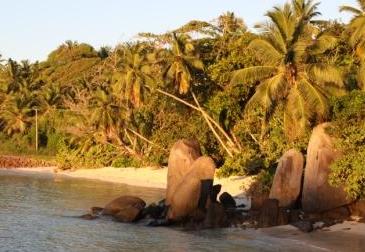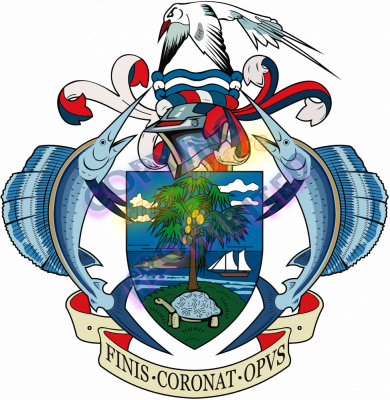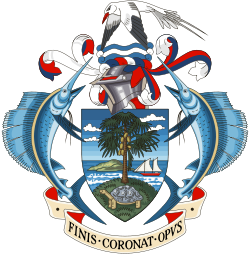Seychelles' Second National Communication
Project Overview
The creation of a National Communication offers countries the opportunity to contribute with technically sound studies and information that can be used for designing mitigation and adaptation measures, and project proposals that can and will help increase their resilience to the impacts of climate change. Activities generally include: V&A assessments, Greenhouse Gas Inventory preparation, Mitigation Analysis or Education, and awareness raising activities. The ultimate goal is the integration of climate change considerations into relevant social, economic and environmental policies and actions.
Project Details
The Seychelles consists of 115 islands with a total land area of 455 km2. Forty-one of the islands are granitic and are located within a radius of 50 km from the main granitic island of Mahe, the most populated in the group. The capital, Victoria, is located on Mahe, which has a land area of 148 km2. The remaining 74 islands are coral islands; Aldabra being the furthest located 1,150 km to the southwest of Mahe. The Seychelles has an Exclusive Economic Zone (EEZ) of 1.4 million km2.
The Seychelles is a multiparty independent state with a mixed-origin indigenous population of just over 78,800 with about 90% residing along the coast. Mahe accounts for 40% of the population. The coastal zone on the granitic islands consists of narrow, flat coastal strips and marshy areas. The plateau area on the islands, which accounts for about 7% of the total land area, is small, but it is where most development including tourism, transport and housing takes place. The urbanisation rate is 2.2% per year.
Located just 40 south of the Equator, Mahe and other main granitic islands are not within the direct track of the tropical cyclones, although they are indirectly affected by such atmospheric perturbations. Trade winds from May to October result in drier conditions, with droughts, which results in severe water shortages, and hence affecting agriculture and all other sectors of the economy.
The small economy of the country is primarily dependent on tourism and fisheries, which provide most of the country's total foreign exchange earnings. The government has been promoting privatisation with a view to increasing domestic investments in the country. The private sector is now employing 48.2% of the labour force. To encourage investment, a 1994 Investment Promotion Act offers a wide range of tax concessions for private sector activities.
The fisheries sector is second to tourism in terms of economic importance. The export of canned tuna, fresh and frozen fish constitutes about 83% of the value of Seychelles’ exports of goods or about 10% of total foreign exchange earnings.
Only about 10% of the 60 km2 of potential agricultural land is being utilised for intensive arable farming. A mountainous terrain and low soil-fertility severely constrains agricultural productivity. The country has now become almost self- sufficient in the production of poultry meat, eggs and pork, while it remains heavily dependent on the import of beef and staples such as rice, potatoes and some fresh produce.
The Seychelles has a per capita (including tourists) water consumption of 140 litres/day (l/d) with an increasing demand in the domestic, tourists, industrial and commercial institutions, and government sectors. Fresh water is an extremely important resource for the Seychelles, especially due to the steep profile of the granitic islands and the small, low-lying coral islands.
Like other oil-importing countries, the Seychelles is vulnerable to oil price fluctuations. Due to increases in tourism and fisheries development, the energy demand increased from 58,000 tonnes of oil equivalent (toe) in 1988 to 102,000 toe in 1994. The energy sector is dominated by the importation of petroleum products, which makes up about 95% of the primary energy supply. The transport sector is the largest consumer of petroleum products after electricity generation.
Presently some 46% of the archipelago’s land and an additional 228 km2 of ocean are legally protected in the form of national parks and reserves. An additional 20-25% are classified as being sensitive and may become protected areas in the near future. The Seychelles has more than 1,000 endemic flora and fauna found nowhere else in the world. The Aldabra Atoll, home of 150,000 giant land tortoises, and the Vallée de Mai Nature Reserve covered in the endemic Coco-de-mer palms, was added to UNESCO’s World Heritage list in 1982 and 1983, respectively.
The quality of the environment supports the booming but exclusive tourism industry. Numerous new initiatives, for example, the Environment Management Plan of the Seychelles (EMPS) 2000-2010 (after the successful implementation of the EMPS 1990-2000) and the National Biodiversity Action Plan provide a framework for enabling sustainable development in the Seychelles. The creation of an Environment Trust Fund has allowed the government to reinvest revenues collected from taxes and donations into environmental protection projects, and to attract private and foreign donations to support its efforts. Eco-tourism is also being developed in a sustainable manner in the Seychelles to ensure proper use of its natural resources.
Source: Seychelles' Initial National Communication (October 2000)
Key Results and Outputs
- Sustainable development and the integration of climate change concerns into medium- and long-term planning
- Inventories of anthropogenic emissions by sources and removals by sinks of greenhouse gases
- Measures contributing to addressing climate change
- Research and systematic observation
- Climate change impacts, adaptation measures and response strategies
- Education, training and public awareness
Potential Adaptation Measures:
Agriculture and Food Security
- Switch to different cultivars
- Improve and conserve soils
- Develop new crops
- Develop and introduce policy measures, including taxes, subsidies, facilitation of free market
- Develop early warning systems and disaster preparedness
Water Resources
- Increase water supply, e.g. by using groundwater, building reservoirs, improving or stabilizing watershed management, desalination
- Decrease water demands, e.g. by increasing efficiency, reducing water losses, water recycling, changing irrigation practices
- Reduce water pollution
Monitoring and Evaluation
In 1992, countries joined an international treaty, the United Nations Framework Convention on Climate Change, to cooperatively consider what they could do to limit average global temperature increases and the resulting climate change, and to cope with whatever impacts were, by then, inevitable.
Parties to the Convention must submit national reports on implementation of the Convention to the Conference of the Parties (COP). The required contents of national communications and the timetable for their submission are different for Annex I and non-Annex I Parties. This is in accordance with the principle of "common but differentiated responsibilities" enshrined in the Convention.
The core elements of the national communications for both Annex I and non-Annex I Parties are information on emissions and removals of greenhouse gases (GHGs) and details of the activities a Party has undertaken to implement the Convention. National communications usually contain information on national circumstances, vulnerability assessment, financial resources and transfer of technology, and education, training and public awareness.
Since 1994, governments have invested significant time and resources in the preparation, collection and validation of data on GHG emissions, and the COP has made determined efforts to improve the quality and consistency of the data, which are ensured by established guidelines for reporting. Non-Annex I Parties receive financial and technical assistance in preparing their national communications, facilitated by the UNFCCC secretariat.





